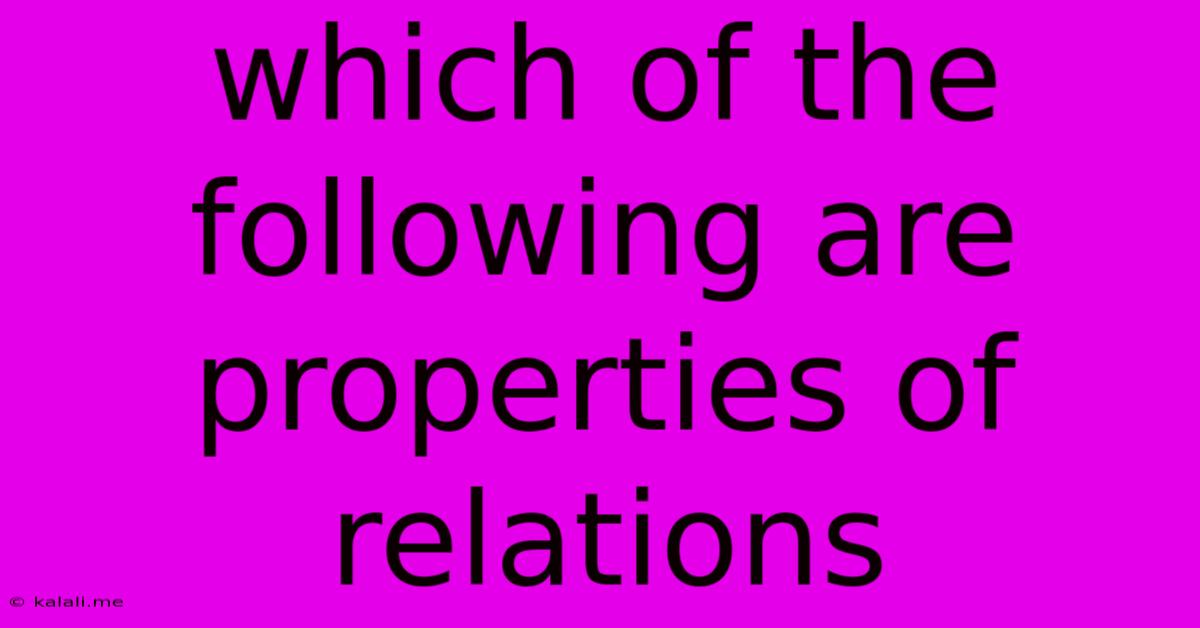Which Of The Following Are Properties Of Relations
Kalali
Jun 16, 2025 · 3 min read

Table of Contents
Which of the Following Are Properties of Relations? A Comprehensive Guide
This article explores the key properties of relations in mathematics, specifically focusing on reflexivity, symmetry, antisymmetry, and transitivity. Understanding these properties is crucial for working with various mathematical structures and concepts. We'll define each property, provide clear examples, and show you how to identify them in different relation scenarios.
What is a Relation?
Before diving into the properties, let's briefly define what a relation is. In mathematics, a relation is a connection or correspondence between elements of two sets (or sometimes within a single set). For example, "is taller than" is a relation between people, "is a divisor of" is a relation between numbers, and "is a subset of" is a relation between sets. These relations can be represented using sets of ordered pairs, graphs, or matrices.
Four Key Properties of Relations:
Now let's delve into the four fundamental properties often used to classify relations:
1. Reflexivity:
A relation R on a set A is reflexive if every element in A is related to itself. Formally, for all a ∈ A, (a, a) ∈ R.
- Example: The relation "is equal to" (=) on the set of real numbers is reflexive because every number is equal to itself.
- Counterexample: The relation "is less than" (<) on the set of real numbers is not reflexive because a number is not less than itself.
2. Symmetry:
A relation R on a set A is symmetric if whenever (a, b) ∈ R, then (b, a) ∈ R. In simpler terms, if a is related to b, then b is related to a.
- Example: The relation "is equal to" (=) on the set of real numbers is symmetric. If a = b, then b = a.
- Counterexample: The relation "is less than" (<) on the set of real numbers is not symmetric. If a < b, then b is not less than a.
3. Antisymmetry:
A relation R on a set A is antisymmetric if whenever (a, b) ∈ R and (b, a) ∈ R, then a = b. This means that if a is related to b and b is related to a, then a and b must be the same element. Note that this doesn't mean that (a, b) ∈ R implies (b, a) ∈ R (as in symmetry).
- Example: The relation "is less than or equal to" (≤) on the set of real numbers is antisymmetric. If a ≤ b and b ≤ a, then a = b.
- Counterexample: The relation "is equal to" (=) on the set of real numbers is also antisymmetric.
- Counterexample: The relation "is a divisor of" on the set of natural numbers is antisymmetric because if a divides b and b divides a, only if a = b.
4. Transitivity:
A relation R on a set A is transitive if whenever (a, b) ∈ R and (b, c) ∈ R, then (a, c) ∈ R. If a is related to b and b is related to c, then a is related to c.
- Example: The relation "is less than" (<) on the set of real numbers is transitive. If a < b and b < c, then a < c.
- Example: The relation "is a subset of" (⊆) on the set of all sets is transitive. If A ⊆ B and B ⊆ C, then A ⊆ C.
- Counterexample: The relation "is a sibling of" is not transitive. If A is a sibling of B, and B is a sibling of C, A is not necessarily a sibling of C (A could be C's parent).
Identifying Properties in Specific Relations:
To determine which properties a given relation possesses, carefully examine the definition of the relation and check if it satisfies each property. Consider all possible pairs of elements within the set. If even one counterexample exists for a property, the relation does not possess that property.
By understanding these four properties—reflexivity, symmetry, antisymmetry, and transitivity—you gain a powerful tool for analyzing and classifying relations in various mathematical contexts. This knowledge is fundamental to understanding more advanced mathematical structures like partial orders and equivalence relations.
Latest Posts
Latest Posts
-
How To Create Clickable Image In Html
Jun 16, 2025
-
What Are The Factors Of 121
Jun 16, 2025
-
What Is A Theme Of The Passage
Jun 16, 2025
-
A Company That Provides Access To The Internet
Jun 16, 2025
-
Which Word Is Closest In Meaning To The Underlined Word
Jun 16, 2025
Related Post
Thank you for visiting our website which covers about Which Of The Following Are Properties Of Relations . We hope the information provided has been useful to you. Feel free to contact us if you have any questions or need further assistance. See you next time and don't miss to bookmark.